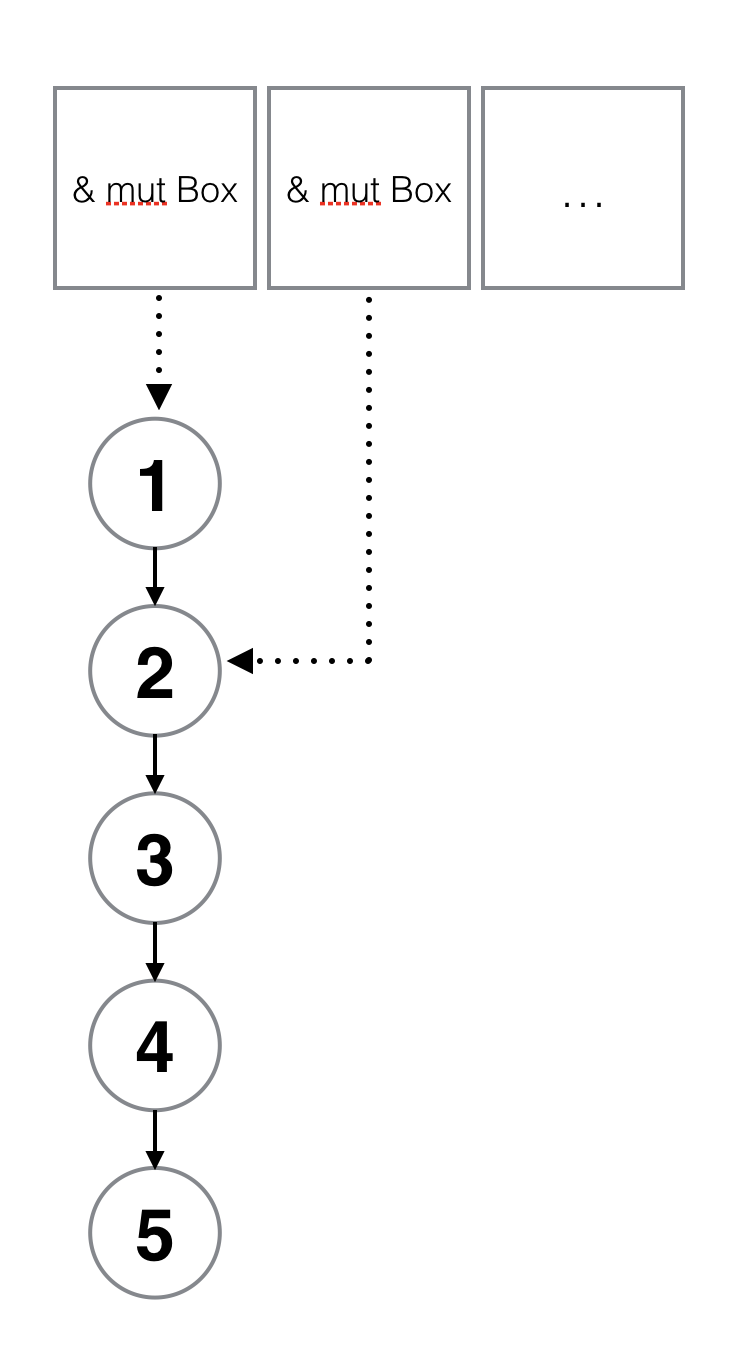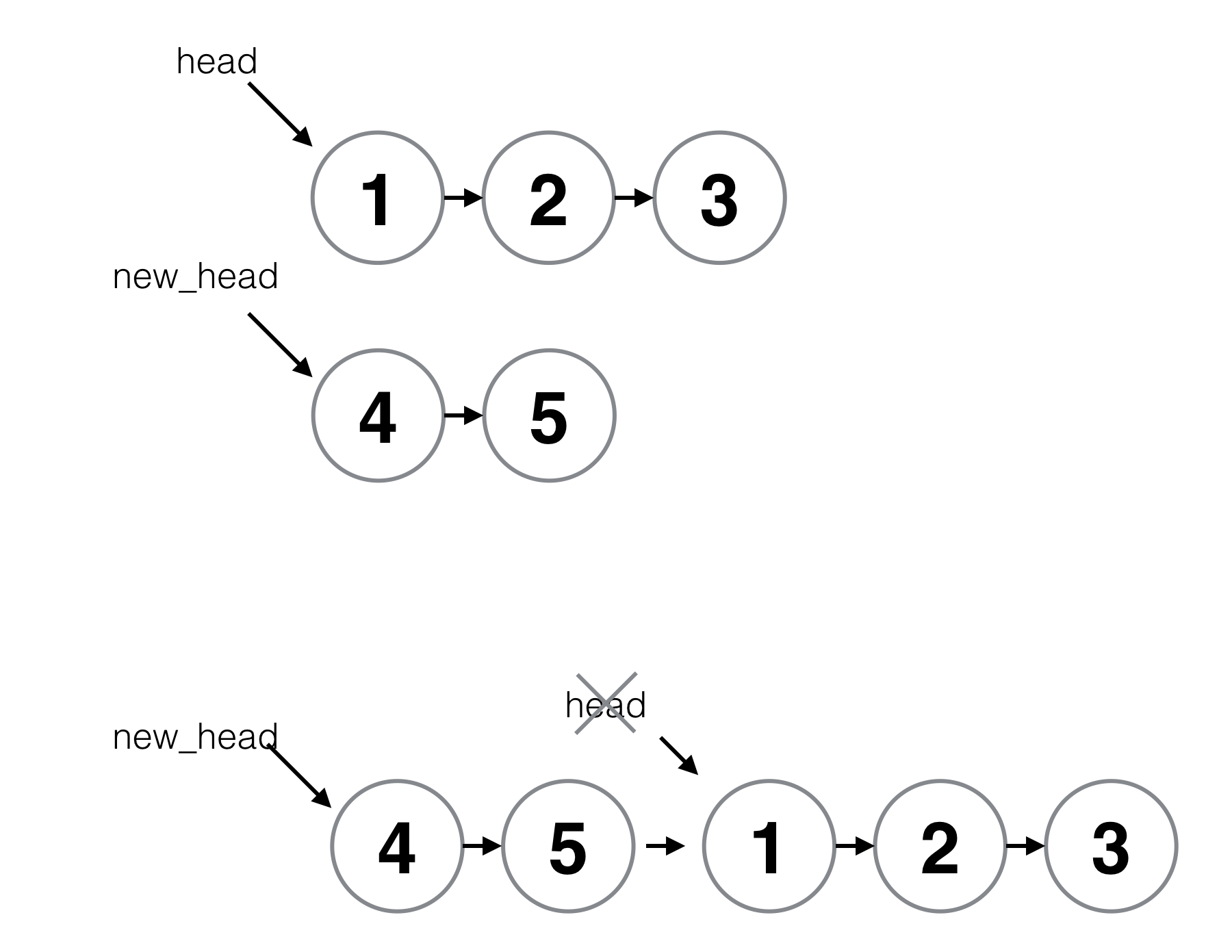在Leetcode中Rust的链表定义为
// Definition for singly-linked list.
#[derive(PartialEq, Eq, Clone, Debug)]
pub struct ListNode {
pub val: i32,
pub next: Option<Box<ListNode>>
}
需要理解的是next字段的类型为Option<Box<ListNode>>,这个类型不存在任何的引用,暗含的意思就是:链表头是整个链表的拥有者,负责整个链表所占据内存的管理(包括最终销毁)。
进一步说,Rust中这样实现的链表和用C++实现的链表是完全不同的:每个节点不再是独立存在的了,而是被先驱节点所管理,同时也管理着它的next字段后所有的后驱节点。
接下来看一下LeetCode上一道简单的旋转链表题:
Given a linked list, rotate the list to the right by k places, where k is non-negative.
Example 1:
Input: 1->2->3->4->5->NULL, k = 2
Output: 4->5->1->2->3->NULL
Example 2:
Input: 0->1->2->NULL, k = 4
Output: 2->0->1->NULL
简单分析例子,题意所要求的操作就是从链表中间某处切开后前后互换(inplace)。

针对这个例子,我第一想法是用一个长度为3的队列遍历这条链表,每经过一个节点就将指向该节点的智能指针Box从队尾加入队列,超出队列长度3的话队头节点离开。这样的话,遍历结束后,队列中剩下指针指向的元素是3,4,5。加上头节点,可以完成所有的操作了,好处是只需遍历一遍。
然而这样的想法用C++写简单方便,但是并不是think in Rust,而且Rust也不允许这么做。
首先我们需要使用队列中的指针对原来的链表进行操作,则推入队列的必须是&mut Box<ListNode>。
到这里已经出现问题了。把一开始的思路用rust写出来,实际得到的是:

链表只有一条,当将头节点指针&mut Box<ListNode>推入队列时,这根指针就已经有了修改整条链表的权利了。显然,第二个指针无法拥有mut权限了,因为不能同时存在同一内存的两个可变引用。
所以说,我的这种只需遍历一遍的方法是无法在Rust中轻松实现的。下面给出AC代码,遍历了两次链表。
impl Solution {
pub fn rotate_right(mut head: Option<Box<ListNode>>, k: i32) -> Option<Box<ListNode>> {
if head.is_none() || k <= 0 { return head }
// Step 1 - loop the linked-list and count total length (Don't need mut)
let mut ptr: Option<&Box<ListNode>> = head.as_ref();
let mut list_len = 0;
while let Some(node) = ptr {
ptr = node.next.as_ref();
list_len += 1;
}
// Step 2 - calculate the curoff place and reach that node using &mut Box
// because this time we want to mutate the list
let cutoff_cnt = list_len - k % list_len;
if cutoff_cnt == list_len { return head }
let mut ptr: &mut Box<ListNode> = head.as_mut().unwrap();
let mut i = 1;
while i < cutoff_cnt {
ptr = ptr.next.as_mut().unwrap();
i += 1;
}
// Step 3 - Split into two list and then concatenate
// head owns one list and new_head owns the other
let mut new_head: Option<Box<ListNode>> = ptr.next.take(); // split
let mut ptr: Option<&mut Box<ListNode>> = new_head.as_mut();
while let Some(node) = ptr {
if node.next.is_none() { ptr = Some(node); break }
ptr = node.next.as_mut();
}
ptr.unwrap().next = head; // concatenate
new_head
}
}
在上面的代码中,我第一遍老实地使用不可变引用遍历一遍链表统计链表长,什么也没有发生。
第二次遍历要用可变引用,但是并没有存储,所以是可以的。到达要切开链表的地方,我用了take()方法将这之后的结点(原先被head所拥有)转移到了由new_head所拥有。
let mut new_head: Option<Box<ListNode>> = ptr.next.take(); // split

最后将剩余的链表遍历完,将最后的None修改成head。现在head失去所有权,整条链表由new_head所拥有。
ptr.unwrap().next = head; // concatenate
总结:在Rust中定义链表,不要再认为节点是孤立的,一个结点代表的就是之后整条链。要对链进行操作,想清楚分裂后的两条链分别归谁拥有。Rust有效地防止了环链表的出现,比如说,一个链表只有一个next字段指向自己的节点。(XD
https://segmentfault.com/a/1190000021699547
Ext Link: https://github.com/Ainevsia/Leetcode-Rust/blob/master/61.%20Rotate%20List/README.md

评论区
写评论还没有评论